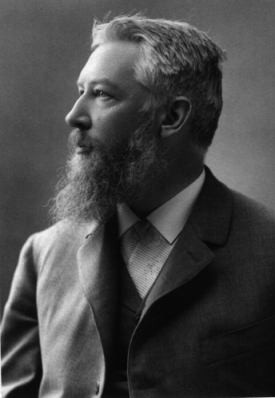Wilhelm Ostwald at the Crossroads of Chemistry, Philosophy, and Media Culture, University of Leipzig, 2-4 November 2000by Joachim Schummer *
When Ostwald received the Nobel Prize of chemistry for his work on catalysis in 1909, he had already retired 3 years ago, at the age of 53, from his chair of physical chemistry at the University of Leipzig. How did this most influential co-founder of the new physical chemistry spend his remaining 26 years at his private estate near Leipzig, after having educated some 100 later professors of physical chemistry worldwide; and why did he finished his successful university career at all?
Did all these activities spring up from his chemistry? Not directly. It rather emerged from philosophical reflections on chemistry. Ostwald himself was quick in elaborating his views towards an abundant and complex philosophy of nature that incorporated even sociology, psychology, ethics, and aesthetics. Though he received harsh criticism from many of his scientific colleagues, his philosophy was throughout scientistic, an all-embracing scientific world view, largely based on three principles: an experimentalist epistemology; the metaphysical priority of energy over matter; and the strongest belief in societal progress by means of science, technology, and social organization. Since for Ostwald progress meant working against the consequences of the 2nd law of thermodynamics, his general demand became: "Do not waste energy – ennoble it!" As a direct consequence, he retired in order to engage in pressing organizational matters, i.e. in more efficient ‘energy flows and transformations’ for societal progress, such as educational reforms and international information and documentation management, or standardization of ‘media’, such as of paper format, an international artificial language, and even money. Moreover, Ostwald considered both war and traditional religion as ‘unscientific’ waste of energy, to the effect that he became a leading figure in both the World Peace Movement and the Monist League, the latter being an atheistic, science-based quasi-religion. Fortunately, there was ample time for discussion during the workshop, for with each paper presenting a new puzzling facet of Ostwald his personality became more and more difficult to comprehend. As a working hypothesis, Anders Lundgreen (Uppsala University) suggested Ostwald’s deeply rooted pursuit of unity and harmony, ranging from his earlier attempts at unifying chemistry and physics to his final theoretical and experimental work on color theory and aesthetics. On the other hand, many papers revealed strong ambiguities, even contradictions within Ostwald’s views, such as between modernism and antimodernism, internationalism and nationalism, anti-metaphysics and metaphysics etc. There was agreement that Ostwald, the restless writer who first used a phonograph in order to save time and energy, took up many ideas from others and changed his topic and mind too frequently to allow a consistent reading of his entire work. While this has given rise to many misunderstandings since, he nonetheless became probably the intellectually most influential chemist of the 20th century. Besides his autobiography and the memoir of his daughter Grete, there is only an early Russian biography of Ostwald worth mentioning (by Rodnyi & Solowjew, 1969; trans. into German 1977). Recent attempts of the Ostwald archive to edit his 10,000 letters as well as the proceedings of this workshop will make the long overdue new biography both more easy and more difficult to write. [Photo courtesy of the Wilhelm-Ostwald-Gesellschaft zu Grossbothen]
Joachim Schummer: |
 Nicely
located at the University of Leipzig, an international workshop organized
by philosopher of chemistry Nikos Psarros and historian of chemistry Britta
Görs, shed new light on widely unknown facets of a great chemist.
To start with the final discussion, the number of papers (16) did not suffice
to cover all his manifold activities. Besides Ostwald the physical, analytical,
and technical chemists, the founder and editor of chemistry journals and
book series, the tireless chemistry textbook writer and historian of chemistry,
there was also Ostwald the quick-witted philosopher, the ardent reformer
and leader of various international movements, the enthusiastic popularizer
of science, as well as the painter and poet who tried to apply the aesthetic
theories on which he had been working so hard during his final 20 years.
Nicely
located at the University of Leipzig, an international workshop organized
by philosopher of chemistry Nikos Psarros and historian of chemistry Britta
Görs, shed new light on widely unknown facets of a great chemist.
To start with the final discussion, the number of papers (16) did not suffice
to cover all his manifold activities. Besides Ostwald the physical, analytical,
and technical chemists, the founder and editor of chemistry journals and
book series, the tireless chemistry textbook writer and historian of chemistry,
there was also Ostwald the quick-witted philosopher, the ardent reformer
and leader of various international movements, the enthusiastic popularizer
of science, as well as the painter and poet who tried to apply the aesthetic
theories on which he had been working so hard during his final 20 years.